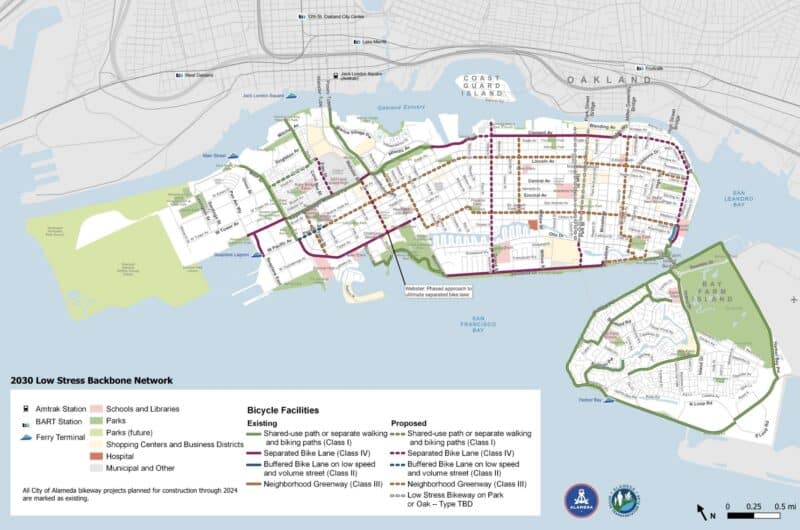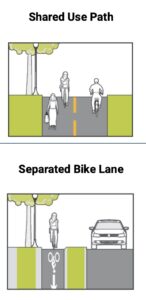The City of Alameda Planning Board held a workshop on October 10 to receive public comment on the Draft Alameda Active Transportation Plan. The Plan describes the work needed over the next eight years to make Alameda a city where people of all ages and abilities feel comfortable walking, biking, or rolling as a preferred mode of transportation. Its goals are to reduce roadway fatalities and injuries, foster a transportation shift, reduce auto congestion and greenhouse gases, and enhance public health and quality of life.

Plan elements

To achieve its goals, the Plan proposes 30 infrastructure improvements and 31 programs to support and encourage a culture of active transportation. Active transportation refers to all active modes of transportation, including walking and bicycling, as well as using wheelchairs and mobility scooters, push and electric scooters, electric bikes, skateboards, and new and evolving shared mobility options, such as bike-share.
The Plan proposes constructing a Low-Stress Backbone Network. This network is a set of low-stress bicycling facilities that, together with existing and planned shared-use paths and separated bike lanes, will provide the “backbone” of a complete, connected bicycle network. The network will help people of all ages comfortably walk, bike, or roll to their destinations, including schools, parks, transit, bridges, shops, and jobs.
Neighborhood Greenways, an example of a low-stress bicycling facility, will be integral to building the network. In Neighborhood Greenways, bicyclists will share travel lanes with vehicular traffic on low-volume, low-speed streets. Treatments may include traffic calming such as speed cushions, traffic reduction treatments such as partial diverters or turn restrictions, pavement markings such as sharrows, and signs to designate the route. Some streets currently designated as Slow Streets, including Pacific, San Jose, and Versailles avenues, would transition into Neighborhood Greenways under the Plan.
Examples of programs to encourage active transportation include installing additional bike parking, developing signage and educational materials about securely locking bikes, distributing educational materials on the benefits of electric and cargo bikes and providing rebates for electric bikes, and developing a citywide wayfinding signage program.
The Plan reports that more than 60 percent of trips in Alameda are taken by automobile, despite more than 60 percent being three miles or less in length. Walking and bicycling comprise only 5 percent of all trips. One goal of the Plan is to increase the percentage of bicycle and pedestrian trips, particularly for trips of less than 3 miles. The Plan proposes that infrastructure improvements and programs be accomplished by 2030.
Public comment
Only one member of the public commented. Cindy J. said that an area for improvement is the performance measures section. She noted that each goal has a performance measure but no actual numbers or target dates. When the City won the silver level for a Bicycle Friendly Community from the League of American Bicyclists last year, she continued, the report card recommended the City become specific and data-driven in its Active Transportation Plan.
The commenter specifically called out the mode shift goal, noting that commute patterns have changed since the pandemic, with more people working from home, so focusing on commuting might not make as much sense. She suggested a specific goal of increasing the percentage of trips done by bicycling or walking to 20 percent by 2030.
Next steps
 The City invites the public to review and comment on the Plan and appendices through October 23. The public may comment through an online survey and at public events and presentations, including:
The City invites the public to review and comment on the Plan and appendices through October 23. The public may comment through an online survey and at public events and presentations, including:
- In-Person Open House, Alameda Main Library, Stafford Room, October 16, 1:30 to 3:30 p.m.
- Virtual office hours, October 17, Noon to 1 p.m., and October 18, 5 to 6 p.m.
- Farmer’s Market Table, 710 Haight Ave, October 18, 9 to 11 a.m.
- Transportation Commission Special Meeting, October 20, 6:30 p.m.
- Social Services and Human Relations Board, October 27, 7 p.m.
After receiving comments from Boards and Commissions and the Alameda community, staff will revise the draft Plan for final review and action by the Transportation Commission in November and the City Council in December.
Contributing writer Karin K. Jensen covers boards and commissions for the Alameda Post. Contact her via [email protected]. Her writing is collected at https://linktr.ee/karinkjensen and https://alamedapost.com/Karin-K-Jensen.




